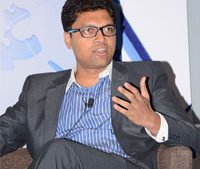INTERVIEW OF THE MONTH

INTERVIEW ARTICLE WITH MR. PRASHANT SINGH,
CIO
Max Health Care
Technology initiatives have always until recently, been the responsibility of the chief information officer. In the context of Indian enterprises, do you see the change happening where CEO’s and COO’s are getting increasingly involved in suggesting or driving these initiatives?
In my journey with various healthcare organizations, I have observed that it depends on individual capabilities or interests to be able to suggest or drive any initiatives. Sometimes a suggestion can lead to a meaningful initiative after having collaborative discussions with relevant stakeholders keeping a specific goal in mind. Most of the time it is a targeted discussion triggered by a strategic or business goal. In my experience, I happened to work with CEO/COOs who were having excellent knowledge of technology along with business orientation, which helped them create an excellent vision for technology initiatives. I have been seeing a lot of involvement in driving or triggering these initiatives.
A lot has been said about why digital projects fail or succeed. In your view, what are the top 3 factors that never fail to contribute to the success of such initiatives?
When we plan for any digital transformation project, it is very important that it should begin with a well-planned strategy comprised of Business objectives, a measure of success, stakeholders with appropriate responsibilities, identification of project enablers, targeted review mechanism etc.
In my view, a few of the important contributing factors are Clear business objectives, Development strategy, people involved in the project, and strong project governance.
Several organizations take a POC route before making RPA decisions. What is your view about taking this route? Is this a good practice?
RPA decision starts with a problem definition and relevant strategies to find an appropriate solution, as we take POC route for various technology solutions so that the proposed technology can be tested before we actually go for the final implementation and the comparison with other technology can also be done for best fit. As per my experience, I feel that the POC route is appropriate for any RPA implementation too so that the project outcomes and measure of success can be pre-defined for achieving a successful implementation. This strategy helps identify the visibility of unknown and hidden pointers, which would have been missed while planning. It should also be governed by well-documented process flows with key performance indicators.
What are the critical success factors to maximize returns from RPA?
RPA is continuously growing because of its applicability in all sizes of enterprises. The technology provides automation for mundane tasks across the business, increases productivity, and efficiency, and cut expenses.
Few critical factors, which can be envisaged before planning for any RPA implementation are:
- The problem must be understood and articulated well before finding the solution from RPA in terms of expectations from automation. The entire use case should be thoroughly studied from the feasibility point of view.
- If direct integration is feasible APIs or scripts and automation can be achieved then the RPA might not be the right technology.
- Rather than starting from the most complex process, we must identify the standard, stable, and most repeatable processes as your first candidates, and leave the complex ones for later.
Many organizations are anxious to bring in AI-based projects. However, if you don’t know why you need RPA, you could end up using the wrong technology for the wrong process.
CIOs are transforming from traditional IT service delivery to a more strategic role. They are no longer just responsible for IT services management, rather they are leading strategic initiatives. What is your opinion of the evolving role of a CIO?
The role of CIO has certainly evolved in the past few years from IT service management to strategic, CIOs are part of management meetings in order to align themselves to the business strategies for the organization and contribute in terms of supporting the business by a lot of digital transformation initiatives. By virtue of their involvement in providing a digital solution to complex processes and workflow, they become knowledge contributors to various key strategic discussions like learning and development, digital marketing initiatives, cost-cutting programs, automation, business process enhancement, etc.
CIOs are acting as key business strategists and work with their C-level peers and board of directors to create business models for meeting market demands. They possess the required skills to drive large-scale change like digital transformation and adoption of new ways of working. They also have the appropriate technical expertise to decide which among the flood of emerging technologies will give their enterprises a business edge over the competition.
CIOs are responsible for making quintessential shifts in organizations to accelerate the digital transformation toward maintaining business continuity and ensuring growth in the post-COVID ecosystem. What in your opinion are some of the important skills a CIO should have to succeed in the post-COVID world?
We all know that Covid has accelerated digital adoption and technical realization. The need of finding business continuity in terms of new business streams and processes gave birth to a lot of new and interesting innovative business ideas supported by technology intervention. There were essential and forceful learnings that came up in order to survive in the acute environment of distress and inability. It has also increased the realization of Digital Technology and accelerated various initiatives, which were otherwise lagging in terms of adoption by users. CIOs need to be geared up in order to align with the post covid era. There are 2 ways an implementation can happen either technology is driving the new process or a new process is asking for relevant technology initiative or support. CIOs have to be business leaders and they need to take on complex projects, which are strategically important to the business and can convince for making investments. They should have the ability to understand what is happening to the business and the market and should be customer aware.
CIOs are being tasked with steering cultural change in their respective organizations to drive the digital transformation efforts that are necessary to support innovation and implement customer-centric strategies. How do you think CIOs are becoming the new agents of change today?
So far, CIO has been doing the role of technology evangelist and a person who is driving various information and technology initiatives as per business requirements, which is aligned with long-term organizational strategy. During and post-Covid there has been a continuous increase in the adoption and realization of digital from a new business stream and efficiency improvement point of view. Awareness of a lot of digital platforms around customer engagement and innovative new business ideas empowers CIOs to be the new agent of change today. Apart from planning for technology, CIOs should also spend more time with business owners in terms of understanding the priorities, customer-centric initiatives, and road map. They are also coming up with a lot of new business streams arising out of digital-first strategies depending on respective business verticals.













